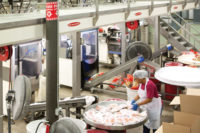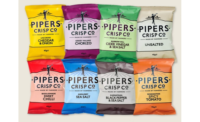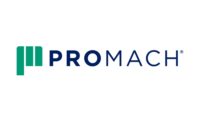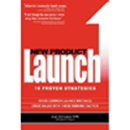Tech at Work
Consistent Coding at High Speeds
By Kent Morris
After decades of using hot-stamping machines for primary package coding, Utz Quality Foods has realized the benefits of thermal transfer overprinting. That includes 33% savings on maintenance and virtually no downtime for code changes.
For operators at Utz, based in Hanover, Pa., a code block change on a hot stamper had been a minimum five-minute job, which is costly downtime for a line marking 100 packages per minute. If a code was printed incorrectly, the misprinted bags had to be torn open to remove the product for repackaging, and the bags were destroyed.
But times have changed at Utz, thanks to the introduction of DataFlex thermal transfer overprinters from Videojet Technologies, Inc. In addition to crisp codes at even the highest line speeds, code changes are a simple matter of a few taps of a touch screen to create the new price and expiration date. That means lost production time has virtually disappeared on the lines with thermal transfer overprinters.
A Million Packages a Day
Utz’s four plants are located within a two-mile radius of Hanover. The company has 50 form/fill/seal packaging machines, all of which use either a hot stamper or a Videojet DataFlex or DataFlex Plus thermal transfer printer for primary product coding.
Maintenance manager Bob Epley says the company produces more than 1 million packages per day. That includes plenty of flexible packaging, primarily 1- to 20-oz. plastic bags for products sold in delis, supermarkets and convenience stores. Additionally, Utz also manufactures 22- to 48-oz. canisters of pretzels, cheese balls and snack/party mixes.
Flexible packages are directly marked, typically with two lines of code — price, expiration date and Utz-specific information such as lot and manufacturer codes. The snack producer codes 140 bags per minute on four packaging machines. For canisters, three to four lines of code information are printed on a pressure-sensitive label, including an internal customer number along with price, expiration date and lot and manufacturer codes. The label is then affixed to the canister.
Moving to Thermal Transfer
Thermal transfer overprinters feature thermal transfer printheads and ribbons that make contact with a flexible substrate, like the synthetic films and labels that comprise Utz’s packaging. Miniature print elements under a glass coating heat small areas of the ribbon and transfer ink to the package. Print elements are program-controlled to create clean, high-resolution bar codes, text and graphics. Thermal transfer printers can be used in both continuous (moving) and intermittent (stop-print-start) environments.
For Utz, any product coding machine has to be able to handle high line speeds while producing consistently readable codes, which was not the case with Utz’s hot stampers, thus prompting changes in 2002. Now, the company has 12 DataFlex printers and four Videojet DataFlex Plus printers, which feature a longer 1,000-meter ribbon, translating to even more time between ribbon changes.
“Today, we changed the product price we’re printing four times on one of our DataFlex machines,” says Steve Sneeringer, Utz machine operator. “All I have to do to change the code is tap the touch screen, create the price and then the expiration date. It takes only a minute.”
Efficient ribbon usage also saves both time and money compared to hot stamping. Sneeringer says the six DataFlex printers in his facility can mark 250,000 bags with one roll of ribbon, compared to 15,000 or less for a hot stamper.
Epley says it will take some time to replace all the hot stampers at Utz’s various facilities with thermal transfer printers. The Videojet DataFlex printers have been so successful that purchases of new units aren’t even debated anymore.
“I put in a purchase order, and there is no discussion about it,” he says.
Editor’s Note: Kent Morris is thermal transfer overprinting product manager at Videojet Technologies, Inc. For more information, visit www.videojet.com.
2007 Baking Expo Opens Registration
It’s time to make plans for the Big Show, the 2007 International Baking Industry Exposition, which runs Oct. 7-10 in Orlando.
The IBIE committee and its marketing firm, San Diego-based Marketing Design Group (MDG), launched a direct mail campaign in March to boost attendance for the show, which runs every three years.
Kimberly Hardcastle-Geddes, MDG account strategist, notes that the direct-mail initiative is part of an international integrated marketing campaign to attract baking professionals from around the world. Over the next few months, the IBIE Committee and MDG plans to rely on everything from e-mail blasts and advertising to the wooing of the international press to attract everyone from tortilla producers to baked snack manufacturers. The committee also is targeting the international industry with brochures printed in six major languages.
Hardcastle-Geddes encourages IBIE exhibitors to develop their own integrated marketing campaign that urge potential customers to attend the show and visit their booths. At the 2004 event held in Las Vegas, about 800 companies exhibited and around 20,000 food industry members visited the show, which is sponsored by the American Bakers Association and BEMA, the baking industry suppliers organization.
Already, prime hotel space near the Orlando Convention Center is going fast. For more information about the 2007 exhibition, visit www.IBIE2007.com. To read more about the show and to link up with the IBIE Web site, visit www.snackandbakery.com.
Marcucci Receives ASB’s Distinguished Service Award
For his years of leadership and dedication to the baking industry, Larry Marcucci, president of Alpha Baking, has received the 2007 Robert A. Fischer Distinguished Service Award from the American Society of Baking (ASB).
A 28-year member of the society, Marcucci has served as chairman of the society and a member of the executive advisory committee. Currently, he’s on ASB’s finance committee and has participated as an industry expert on numerous panels during the society’s annual conferences over the years.
Thomas Kuk, ASB president, notes that Marcucci is the first baker to win the award.
“Larry really has a passion for the society,” Kuk notes. “He continues to get to get the people for work for him to be involved in the society and in industry affairs as well. Most importantly, as president of his company, he is one of those individuals who truly leads by example.”
Previous winners include Robert Fischer, Paul Kamman, Rella Dwyer, Don Bianchi, Don Dubois, Bill McCurry and Winn Horn.





